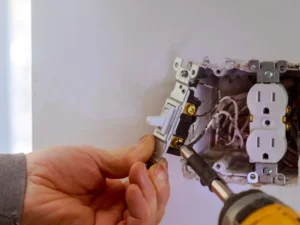
DIY Troubleshooting Electrical Safety: Tips for Homeowners
Electricity is like the invisible lifeblood of your home, humming away under the surface, quietly powering everything from your refrigerator to your favorite neon sign. But what happens when a metaphorical ‘thunderstorm’ hits and you’re left in the dark? Ah, the heart-wrenching decision: DIY troubleshooting or that emergency electrician call.
Safety always comes first in the heart of any home, and electrical systems aren’t just complex; they have the potential to be life-threatening if mishandled.
The Initial Spark: Common Electrical Issues
Before we discuss the when and how of summoning a professional, it’s worth recognizing the telltale signs that something is sparking trouble:
- Light bulbs constantly burning out too quickly may be a sign of poor wiring.
- Electrical outlets can become hot or show burn marks, indicating a serious issue.
- Flickering lights when an appliance kicks in can tell that your circuit is overloaded.
- Your breaker panel might be tripping frequently, signaling a circuit overload or a short circuit.
The DIY Playbook
Your first step should always be a calm, collected assessment. Don’t just jump into the deep end; it’s vital to test your switches and outlets, replace any faulty wiring if visible, and maybe even treat your home to some new, fancy lightbulbs if that’s where the problem seems to lie.
Step 1: Overloaded Circuits – A Common Culprit
Think of your home’s electrical circuit like a pie – only so many slices to go around. Plugging too many appliances into one outlet, especially those that consume a lot of energy, is like trying to feed Aunt Mabel’s casserole to the entire neighborhood. A good rule of thumb? Respect the pie and redistribute your appliances so that no single circuit is carrying too much.
Step 2: The Mysterious Case of the Flickering Lights
This is one of the more peculiar occurrences that can boggle homeowners. The culprit may be as simple as a loose bulb or more complex, like an issue in your home’s grounding system. Start simple – tighten those bulbs. If the problem persists, it might be time to ground yourself and consider the professional leap.
Step 3: Switch Sally’s Silent Operation
Poor Sally, the pet name you’ve given your seemingly unreliable light switch. It might have reached its retirement with dignity, or the wiring behind it could be on the fritz. A switch is relatively easy to replace if you’re feeling confident, but make sure to consult a professional if the problem extends beyond the visible.
When to Pull the Plug on Your DIY Efforts
What it comes down to is the finer details. If you’re standing with a tangled mess of wires, you might want to remember that professionals have as many years of schooling and apprenticeship under their tool belts as the quarterback of your high-school football team did sports training.
You Aren’t “Just Changing a Lightbulb” Anymore
Sure, some issues are as easy as A-B-C. But once you go past the simple components, you start venturing into the realm of situations where a professional touch is the best way to ensure safety and resolution. It’s like baking a cake from scratch; changing a bulb is a simple mix of ingredients, and electrical work is the molecular gastronomy that requires precision and understanding of the materials involved.
The Circuit of Trust
Your circuitry isn’t just a complex system; it’s bespoke to your home and its needs. Working on it yourself might save a few dollars, but it can also create a game of unpredictable electricity, where the stakes are higher than a simple blackjack game. Calling a professional might seem like investing in the stock market; it costs you a bit now, but it can save you from a catastrophic loss down the line.
The Professional’s Playbook
Now that you’ve decided to call in the pros, what can you expect from the electrical Maestros? They’ll arrive at your home ready to diagnose and resolve issues with the precision of a surgeon. Here’s why their expertise is invaluable:
- Wire Wizards: Electricians bring years of knowledge and experience to their work. They can trace currents through your home’s labyrinth-like wiring with ease, diagnosing and fixing problems that could have left you scratching your head or, worse, nursing an electric shock.
- Safety First, Second, and Always: Electricians are equipped with more than just a toolbelt; their expertise means they respect and understand the dangers present in the electrical complexities of your home, a treatment that a convenience plug-in surge suppressor doesn’t offer. Safety and preventing hazards are as much a part of their job as screwing in a lightbulb is for you.
- Future-Proofing Your Home: When an electrician works on your home, they might just be saving you from a future fire hazard or electrical failure. Their work is a preventative measure, ensuring your home can handle the Ever-changing energy needs of the modern world.
- Assurance of Workmanship: In the unlikely event that an issue arises after your electrician has worked their magic, they’re just a phone call away. Many offer guarantees on their work, underscoring their commitment to excellence and peace of mind.
In closing, your home’s electrical systems are a modern marvel, but with great power comes great responsibility – and the occasional need for a professional. Sure, DIY has its place. But when it comes to those intricate currents flowing through your walls and floors, a seasoned electrician might be what you need to keep everything humming.
